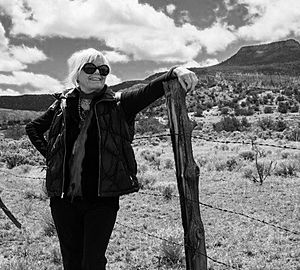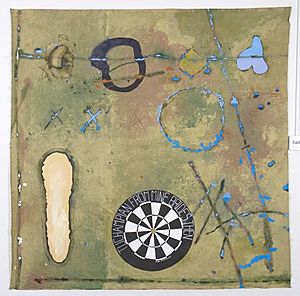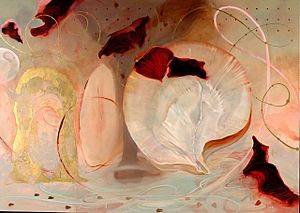Ciel Bergman facts for kids
Quick facts for kids
Ciel Bergman
|
|
|---|---|
 |
|
| Born |
Cheryl Marie Bergman
September 11, 1938 |
| Died | January 15, 2017 (aged 78) |
| Nationality | American |
| Alma mater | San Francisco Art Institute California State University |
| Known for | Painting |
| Awards | SECA Art Award, 1975 Louis Comfort Tiffany Award, 1980 |
Ciel Bergman (born Cheryl Marie Bowers, September 11, 1938 – January 15, 2017) was an American painter. She was known for her unique art style. Her work often focused on the environment and themes related to women.
Contents
Becoming an Artist
Ciel Bergman was born in Berkeley, California. Her birth name was Cheryl Marie Bowers. Before she became a famous artist, she trained to be a nurse.
In the 1960s, she started taking private art lessons. She studied with portrait painters Peter Blos and Vincent Perez. At the same time, she worked as a Registered nurse in a hospital.
She won her first painting award in Oakland. After that, she went back to school to study art more deeply. In 1973, she earned a special degree in painting from the San Francisco Art Institute. She studied with important artists like Fred Martin.
Her Artwork
Ciel Bergman created many different types of art. She made paintings, drawings, and prints. She also used photography and built art pieces.
She often used images of water, roses, and rose petals in her art. These images helped her tell stories and share ideas. In the mid-1980s, her paintings explored ideas about goddesses. She used symbols that come from our shared human experiences.
Art for the Environment
In 1987, Bergman created a powerful art show. It was called Sea of Clouds What Can I Do. This show highlighted the big problem of plastic recycling.
She filled an entire art gallery with seven huge dumpsters of plastic trash. This plastic was collected from four miles of Santa Barbara's Pacific Ocean coastline. It took her several months to gather all the waste.
The art show also included painted walls and sounds. There was a video she made herself. Visitors could also take part by adding to a special altar. The whole room looked like a place after a disaster. Plastic was everywhere, even hanging from the ceiling. This art piece really made people think about plastic pollution.
Plasphalt: Roads from Plastic
Ciel Bergman had a brilliant idea about plastic. She realized that plastic is made from petroleum, just like asphalt (the material used for roads). She thought, "What if we could use recycled plastic to build highways?"
She shared her idea with Gary Fishback. He helped her develop it and got a special patent for it. They called it Plasphalt™.
What is Plasphalt?
Plasphalt is a mix of recycled plastic and asphalt. The plastic is heated and added to the asphalt. This helps to reduce the amount of petroleum needed. It also helps to lower pollution.
Even though Plasphalt was a bit more expensive at first, it had a big advantage. Roads made with Plasphalt lasted 25% longer than regular roads! This means less need for repairs.
Building Roads with Plasphalt
In 2002, Plasphalt was used to build a two-mile section of New Mexico's I-25 highway. This project used a lot of waste plastic. It helped to keep 27% of all local waste out of landfills.
Companies like Philips Semiconductors, Intel, and Coca-Cola helped supply the plastic. Sadly, the company that made Plasphalt in the US went out of business. This was due to a lack of support from the local government.
However, the idea of Plasphalt lives on! It is now used to build roads in countries like China and India.
Benefits of Plasphalt
Using plastic in asphalt has many benefits. The plastic makes the roads more waterproof. This means they are more resistant to rain, snow, and ice.
Another great thing about Plasphalt is that it can use many different types of mixed plastics. This makes recycling much easier. You don't have to carefully sort all the different plastics. Just one mile of road can use 100 to 200 tons of Plasphalt. This helps to clean up our planet!
Teaching and Awards
Ciel Bergman was also a professor. She taught at the University of California, Berkeley. Later, she became a full professor at the University of California, Santa Barbara. She taught there for many years, from 1976 to 1994. She also worked to support women in academia.
She received several important awards for her art. In 1975, she won the SECA Art Award. She was also included in the Whitney Biennial, a big art show in New York. In 1980, she received the Louis Comfort Tiffany Award.
Her Name Change
In 1988, on her 50th birthday, Cheryl Marie Bowers made a special decision. She legally changed her name to Ciel Bergman. "Ciel" means "sky" in French. "Bergman" was her Swedish grandmother's last name.
She felt this name change was important for her as an artist. It connected her to her family and to nature. Her new name, Ciel Bergman, means "sky" and "mountain." These are often seen in the backgrounds of her paintings.
Where Her Art Is Kept
Ciel Bergman's artwork is displayed in many famous museums and collections. You can find her pieces in places like the Metropolitan Museum of Art in New York City. Her art is also in the Oakland Museum of California and the National Gallery in Washington, D.C. Many private collectors in the US, Europe, and Asia also own her work.



